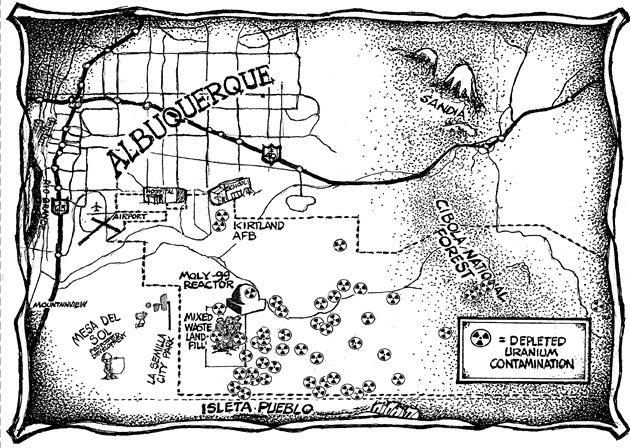
Santa Susana Field Laboratory (SSFL)
Santa Susana Field Laboratory is one of 39 environmental and peace organizations that won a landmark lawsuit against the U.S Department of Energy for failure to follow-through on adequate environmental cleanup during its 50+ years of nuclear weapons research, testing, and production. Part of this settlement was the establishment of the MTA Fund (Citizens’ Monitoring and Technical Assessment Fund), which provided $6.25 million for tribes and non-profit organizations to assess and conduct independent technical and scientific studies regarding the multitude of technical, ecological, and health issues surrounding the nation’s nuclear weapons complex.
Clark University was chosen by the non-profit peace and environmental groups as the conservator of these reports to ensure they remain available to the public in perpetuity. The unconventional election of university as conservator is an innovative example, particularly within the era of Web 1.0, of higher education as protector and provider of information through wide dissemination.
The research and reports available in this series were conducted by the Santa Susana Field Laboratory with their allocated portion of the MTA fund.
If you have any questions or concerns please contact us at digitalrepository@clarku.edu.
-

Feasibility of Developing Exposure Estimates for Use in Epidemiological Studies of Radioactive Emissions from the Santa Susana Field Laboratory
Jan Beyea Ph.D.
This report provides exposure estimates to assist epidemiologists in deciding on the effectiveness of studies of radiation-induced disease around the Santa Susana Field Laboratory (SSFL). Developing such estimates was a difficult challenge, because the site is extremely complex from the meteorological perspective, there is limited information available about releases of radioactivity in the 1950s and 60s, and some meteorological data is withheld by the plant owner. As a result, the estimates in this report are limited to scoping calculations that carry a wide range of uncertainty, complicating their use for estimation of statistical power. Nevertheless, they represent the current state of knowledge about the accident and its consequences, as reflected in the opinion of experts who have analyzed the event.
This research was completed money allocated during Round 2 of the Citizens’ Monitoring and Technical Assessment Fund (MTA Fund). Clark University was named conservator of these works.
If you have any questions or concerns please contact us at digitalrepository@clarku.edu
-

An Assessment of Potential Pathways for Release of Gaseous Radioactivity Following Fuel Damage During Run 14 at the Sodium Reactor Experiment
David A. Lochbaum and Santa Susana Field Laboratory
An assessment of potential pathways for release of gaseous radioactivity following fuel damage during Run 14 at the Sodium Reactor Experiment. The Sodium Reactor Experiment (SRE) featured a sodium-cooled, graphite-moderated nuclear reactor. As implied by its name, the primary purpose of SRE was not to generate electricity but rather to test the performance of the sodium-cooled, graphite-moderate reactor design, fuel element designs, and the performance of materials. The reactor would be started up and operated for a period, then shut down for examinations and/or to reconfigure test conditions. These periods of reactor operation were termed power runs. Run 14 took place on July 12, 1959. During run 14, the thermocouples that monitored the temperatures at the exit of individual fuel channels in the reactor core and plotted them continuously on a recorder in the control room showed large (greater than 100ºF) differences. Some differences were to be expected due to variances in fuel element power levels and fuel channel cooling flow rates, but the magnitude of the observed differences could not be explained.
This research was completed money allocated during Round 2 of the Citizens’ Monitoring and Technical Assessment Fund (MTA Fund). Clark University was named conservator of these works.
If you have any questions or concerns please contact us at digitalrepository@clarku.edu
-

Report of the Santa Susana Field Laboratory Advisory Panel
Santa Susana Field Laboratory
In 1989, press reports revealed an internal U.S. Department of Energy (DOE) study that found widespread radioactive and chemical contamination at the Santa Susana Field Laboratory. Legislators, responding to community calls for independent health studies in the wake of revelations about the site, arranged for the establishment of the Santa Susana Field Laboratory Advisory Panel, to consist of independent experts from around the country (and one from Britain) as well as community representatives. The legislators directed that the initial studies should be of the workers, as they were likely to have higher exposures.
The legislators who established the Panel had directed – and the Panel had committed to the community – that if the worker studies came back with positive findings, the Panel would turn its attention to studying potential impacts on the community, including the feasibility of performing an epidemiological study.
The UCLA researchers’ radiation study was released in 1997 and found that exposure of SSFL workers to external radiation was associated with an elevated rate of dying from cancers of the blood and lymph systems and from lung cancer; death rates for all cancers and for “radiosensitive” solid cancers were found to increase as external radiation dose increased; and exposure to internal radiation emitters similarly resulted in increased rates of dying from cancers of blood and lymph systems and cancers of the upper aero-digestive tract. The researchers found these effects arising from doses well below those permitted by current regulations. They found radiation risks about 6-8 times higher than those generally extrapolated from A-bomb survivor data, and they found that cancer rates were impacted more by radiation that workers received at older than at younger ages.
Upon release of this 1997 study and of the rocket testing workers in 1999, the Panel’s work was re-directed to studying possible offsite effects/community impacts of SSFL.
This is a report summarizing the panel's next phase of work and the resulting research.
This research was completed money allocated during Round 2 of the Citizens’ Monitoring and Technical Assessment Fund (MTA Fund). Clark University was named conservator of these works.
If you have any questions or concerns please contact us at digitalrepository@clarku.edu


